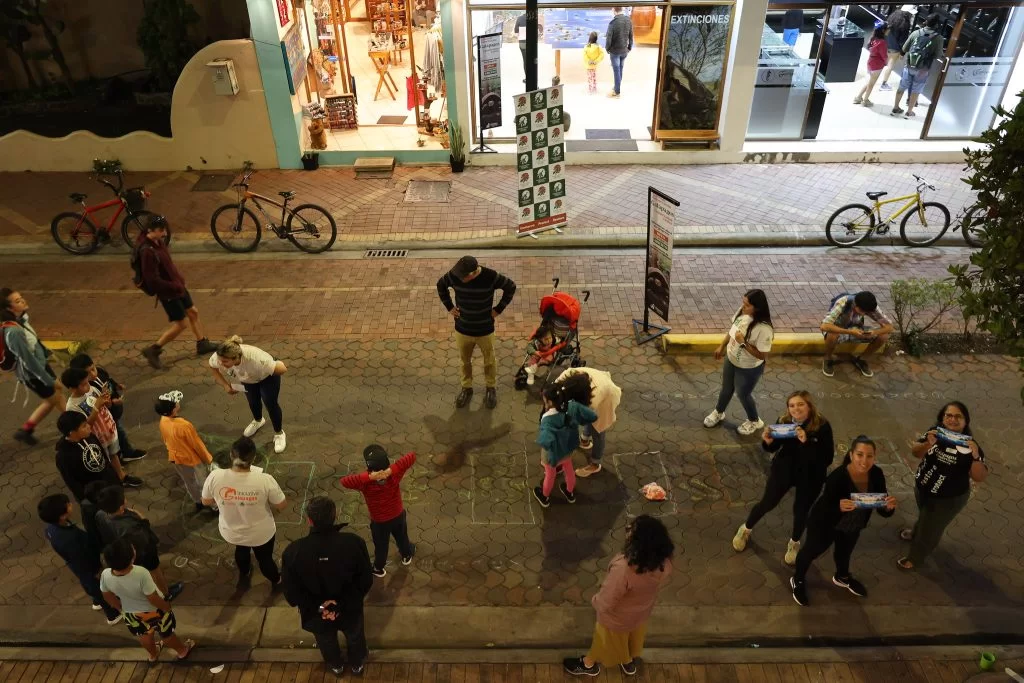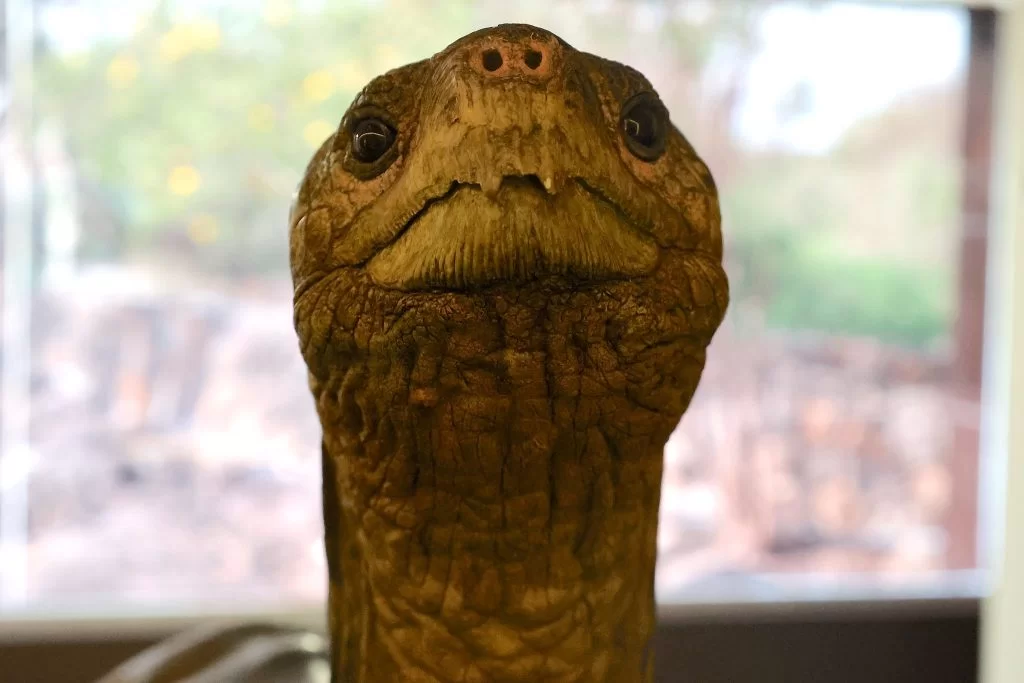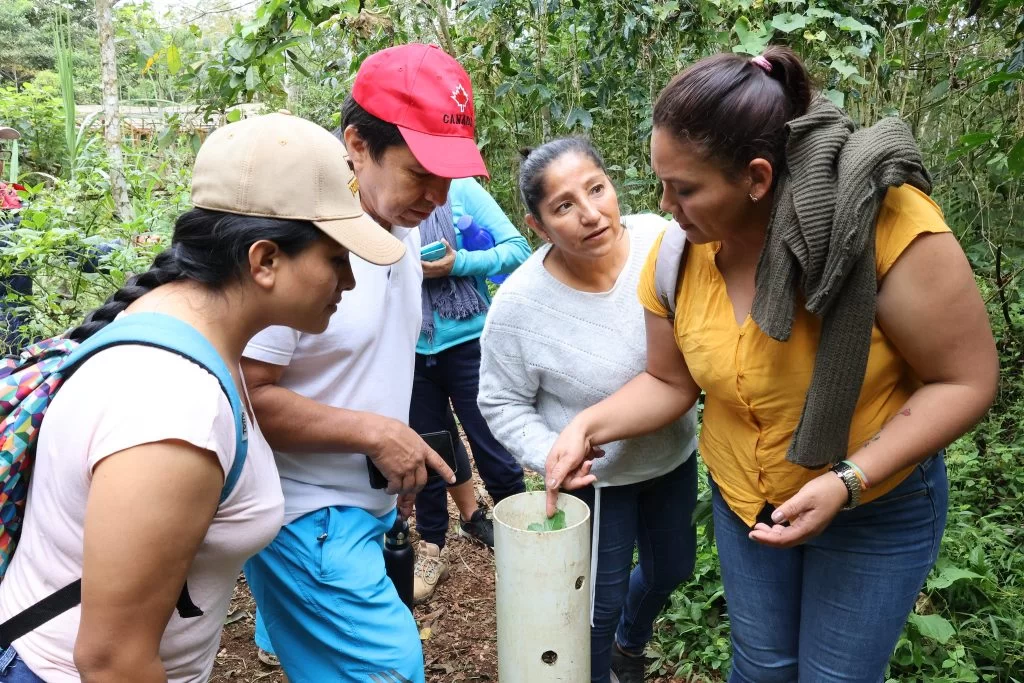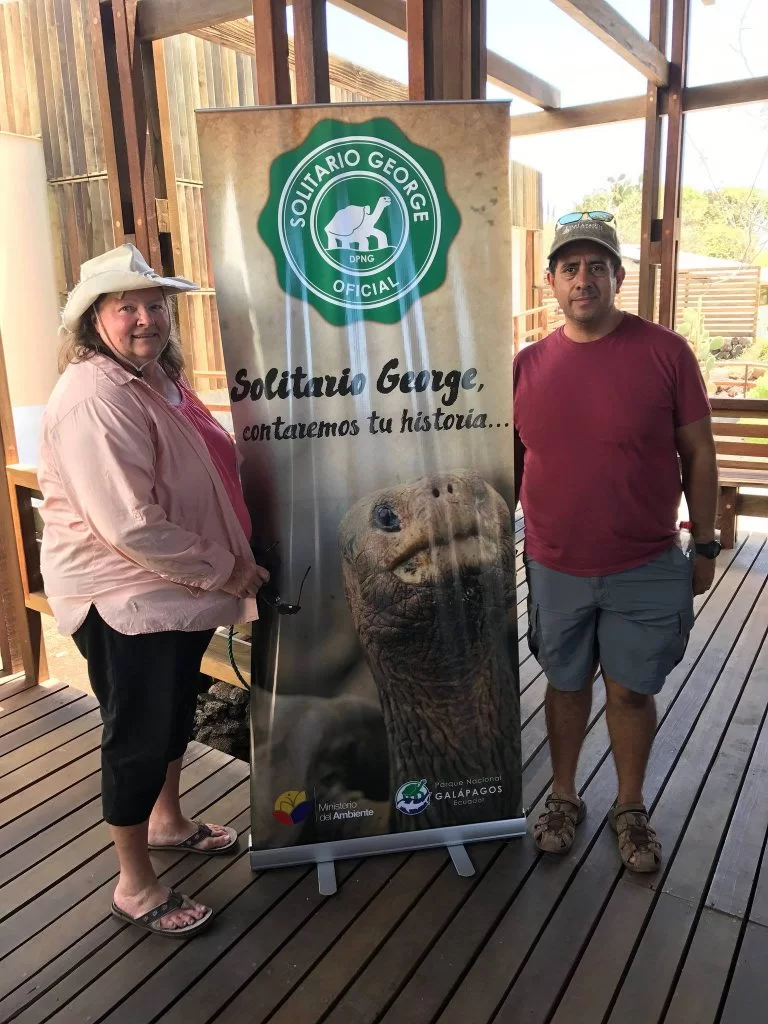Ivonne Torres, Conservation Center Coordinator, describes the Conservation Center’s purpose as an area for inquiry and learning about Giant Tortoises history and current status. She also provides information about conservation programs for this famous species. Ivonne also spoke about how volunteers and she work with local youth to raise awareness about Galapagos conservation. She shared that children and students from universities often visit her to learn more about the difficulties we face in protecting Galapagos biodiversity.
Dr. Diego Paez is a professor at the College of Biological and Environmental Sciences of the Universidad San Francisco de Quinto. Students receive direct information from conservationists during their interpretive visits to The Conservation Center. He said that students will be able to better see the work being done in caring for Galapagos and they will eventually take over conservation efforts [in the Islands].”
Galapagos Conservancy provided training for university students in interpretive communication skills. They participate in recreational activities every Friday as part of their community outreach internships. This is to help revitalize Charles Darwin Avenue.
Ivonne believes that didactic games that stimulate or encourage learning are useful educational tools. “We have used traditional games like hopscotch, dice, and other similar games to teach conservation through questions, answers, and that is part of our conservation education program.”
The Galapagos community is essential in protecting one of the most beautiful and well-preserved archipelagos in the ocean. In recent years, society has had a greater impact on the environment due to increased natural resource consumption and waste generation. This negatively impacts ecosystems. To ensure the Archipelago’s sustainability, it is crucial to provide environmental education for youth.

Conservation Center interactive games on Friday nights © Galápagos Conservancy
The Symbol Of Hope Hall is located on “La Ruta De la Tortuga”, an interpretive trail of the Galapagos National Park Directorate. Galapagos Conservancy funded the refurbishment. It was done under strict guidelines set by George Dante, the expert taxidermist responsible for Lonesome George’s taxidermy process that lasted nearly three years.
Lonesome George, a Pinta Island reptile, is still a very popular name ten years after his passing. Washington Tapia (General Director of Galapagos Conservancy) led the process. He stated that every effort was made to preserve Lonesome George’s taxidermied body, which is a symbol for conservation efforts in Galapagos.
A group of scientists from the University of California, Berkeley visited Pinta Island in 1971 and discovered the only giant tortoise to have ever lived on the island. In 1972, a new expedition was set up to Pinta to find the specimen. It was named Lonesome George and transferred to the Galapagos National Park Breeding Center. The chelonian spent the rest of his days in his new home until his death from natural causes on June 24, 2012. He left no descendants.

Close-up of Lonesome George © Galápagos Conservancy
Renewable energy was the integrating theme of the Institute. This topic is essential to the Ministry of Education’s June 2021 launch of local schools on the topic. Teachers, trainer-leaders, experts in renewable energy, and training facilitators helped educators create monthlong units of instruction that they will use with the 7,000 Galapagos students over the course of the week. EPI Ecuador and Villanova University were both able to share technical information with educators as well as engage international experts in this area. We are very grateful.
Students are not taught about sustainability and conservation issues in most schools around the world. UNESCO’s “2030 Agenda for Sustainable Development” reports that 47% of all national education programs do not mention climate change. Only 40% of teachers feel comfortable teaching about it, and only 20% of teachers report being able see how societies can address this global threat.
Galapagos students learn science, math, and language arts within the context of real-life conservation and sustainability cases. This approach to education has been proven to help students learn core subjects, as well as develop critical thinking skills and problem-solving skills. This method also helps students to understand and appreciate their environment and encourages them towards a sustainable mindset throughout their lives.
The Education for Sustainability Program was born from a June 2014 diagnostic analysis by Galapagos Conservancy and Fundacion Scalesia. It is a plan to strengthen public education in the Islands. The program introduced a cyclical training model in 2016 that included Teacher Institutes (two per annum), teacher observations and reflections (instructional coaching) and professional learning circles. Each year, the program offers more than 220 hours intensive, research-based training for every Galapagos teacher.
Teacher motivation and commitment have reached all-time highs in the seventh year, which is the last of the 10 years planned for the program. Many teachers are also demonstrating greater mastery over new, proven educational strategies. The program has trained teacher-leaders who are actively involved in professional development and coaching others. Numerous local individuals and organizations are also sharing their expertise with students and teachers on a regular base.
We believe that this collaborative effort will help young people in Galapagos build better communities and ensure that the world treasure is preserved for future generations.

Teaching Institute 2022 © Galápagos Conservancy

Dr. Linda Cayot with Washington Tapia © Galápagos Conservancy
Through art and engaging games, two environmental education projects were displayed at the fair. These included learning about Galapagos’ flora & fauna and how to take care of their environment, including the Galapagos Marine Reserve species.
Three projects were also presented by organizations to promote the consumption and production of local products. These initiatives helped to provide a variety of local products that promote a healthy and low-calorie diet. These products included whole wheat bread, gluten free bread, sauces of any kind, dehydrated fruits and a variety of organic vegetables.
Gabriela Vivas is the Director of Operations at Conservando Galapagos. She says that local consumption has a significant environmental impact, especially in Galapagos. Reduced transportation of goods to the Islands reduces greenhouse gases and other pollutants. Vivas stated that “for these and other reasons we must consume locally.”
A wooden handcraft project was presented and a dance choreographed by local artists highlighted the artistic side of the event. They promote the responsibility to care for the unique and natural environment of the Galapagos Islands through their art.
Galapagos Conservancy provides spaces and opportunities for the community, to learn about the initiatives and institutions of enterprising citizens.

Dancers at exhibition at fair in Santa Cruz © Galápagos Conservancy
The workshop was held in September’s third week. Experts carefully assessed each species’ status from “least concern to extinct”, including those species that are commercially exploited and have become difficult or rare to find.
Eduardo Espinoza is a specialist in marine resources at Galapagos National Park. He says that some species of the IUCN-evaluated species are related to artisanal fishing in Galapagos. The Environmental Authority will implement management measures to ensure sustainable and conservation of these resources. “We examined species that hadn’t been seen for decades. Espinoza said that there will be more research, monitoring and searches to find out if they are extinct in GMR.
Neil Cox, Director, IUCN Global Species Program stated that the IUCN Red List of Galapagos endemic fishes will be updated in the next year based upon the workshops. Cox stated that after the workshop, there will be a lengthy review of all data and ensuring that the evaluation protocol was followed in order to confirm the consensus decisions reached at the workshop.
James Gibbs is the Vice President of Science at Galapagos Conservancy. He stated that this information will help to guide decision-making and support conservation and sustainable use.
Many species, including the Galapagos-based bacalao cod, were identified as being at risk from overfishing. Experts also identified fish species that were not well-known and do not have sufficient data to determine their current status. Their conservation status will require further research and observation.
The hope was that the Galapagos Damselfish would be rediscovered, as it has not been seen since 1980s. Galapagos Conservancy has begun funding intensive research to find the Damselfish because workshop participants rated it as potentially extinct and critically endangered.